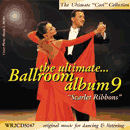Learn to Dance: Rumba

The romantic, sensual Rumba
(Photo: Emeral Ball 2008)
History of Rumba - The Rumba, originally from Cuba, is a romantic and sensual dance. It was introduced to the United States in the early 30's, and has remained one of our most popular social dances.
The Rumba, with is its rhythmic hip motion and distinctive walking step, is always a crowd favorite. This authentic body action produced by movement of the legs, hips and ribcage, is known as "Cuban motion" or "Latin hip movement".
Three styles of Rumba were introduced to Americans. The slow Bolero-Rumba (shortened to Bolero), the moderate tempo Son-Rumba (shortened to Rumba) and the faster Guaracha-Rumba. The popular Rumba and Bolero have survived the test of time. The Guaracha-Rumba quickly faded from popularity when the more exciting Mambo was introduced to Americans in the late 40's.
The Cuban Rumba first began as an expressive, pantomime-like dance performed by natives to the tantalizing rhythm of Afro-Cuban drumbeats. Early Rumba patterns evolved from the country's folk dances, where movements are often based on events in daily life. For example, the circling movements of birds during the courtship season has developed into popular walking movements on the dance floor, now known as "Cuban Walks". Our social Rumba has, of course, progressed a long way from these fascinating native patterns and has blossomed into the beautiful, romantic dance it is today.
Music and Tempo - The Rumba music is written in 4/4 time and should be played at a tempo at 30-32 measures per minute. Two rhythms are used: Q,Q,S - Q,Q,S (musically, 1,2,3, hold 4 - 1,2,3, hold 4) OR S,Q,Q, - S,Q,Q, (1, hold 2, 3, 4 - 1, hold 2,3, 4). Either rhythm can be used, but not changing during the dance.
Style - The Rumba is a spot dance not moving along the Line of Dance. Steps are usually compact, with feet no more than 12 inches apart. Cuban Motion (or Latin Hip Movement) is the authentic rolling action of the hips from side to side. It is generally smooth and subtle while danced throughout the Rumba.
| Step | Rhythm & Beats |
Foot Movement |
Footwork | Amt of Turn |
Dance Position |
|---|---|---|---|---|---|
| 1 | Q-1 | LF side | B fl | Optional- Up to 1/2 turn to left over steps 1-6 |
Closed Dance Position throughout |
| 2 | Q-2 | RF close | B fl | ||
| 3 | S-3,4 | LF fwd | B fl | ||
| 4 | Q-1 | RF side | B fl | ||
| 5 | Q-2 | LF close | B fl | ||
| 6 | S-3,4 | RF bk | B H | ||
| Definitions - Click here | |||||
| Step | Rhythm & Beats |
Foot Movement |
Footwork | Amt of Turn |
Dance Position |
|---|---|---|---|---|---|
| 1 | Q-1 | RF side | B fl | Optional- Up to 1/2 turn to left over steps 1-6 |
Closed Dance Position throughout |
| 2 | Q-2 | LF close | B fl | ||
| 3 | S-3,4 | RF bk | B H | ||
| 4 | Q-1 | LF side | B fl | ||
| 5 | Q-2 | RF close | B fl | ||
| 6 | S-3,4 | LF fwd | B fl | ||
| Definitions - Click here | |||||

 Online Music Store
Online Music Store